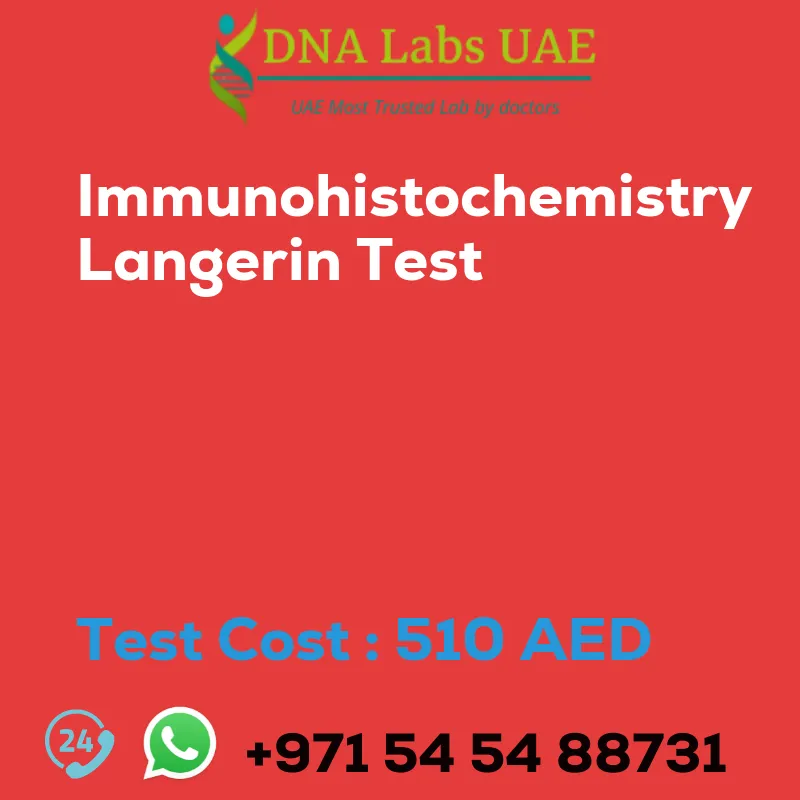IMMUNOHISTOCHEMISTRY LANGERIN Test
Components: Price 510.0 AED
Sample Condition: Submit tumor tissue in 10% Formal-saline OR Formalin fixed paraffin embedded block. Ship at room temperature. Provide a copy of the Histopathology report, Site of biopsy and Clinical history.
Report Delivery: Sample Daily by 6 pm; Report Block: 5 days Tissue Biopsy: 5 days Tissue large complex: 7 days
Method: Immunohistochemistry
Test type: Cancer
Doctor: Oncologist
Test Department: HISTOLOGY
Pre Test Information:
Langerin is a protein that is expressed in certain immune cells, particularly in a type of immune cell called Langerhans cells. Langerhans cells are found in the skin and mucosal tissues, and they play a role in immune responses and antigen presentation.
Immunohistochemistry is a technique used to detect specific proteins in tissue samples. It involves the use of antibodies that can bind to the target protein, followed by the detection of the antibody-protein complex using a detection system such as a colored dye or fluorescent molecule.
To perform an immunohistochemistry Langerin test, tissue samples are first fixed and embedded in a solid matrix, such as paraffin or frozen sections. The tissue sections are then treated to remove any endogenous peroxidase activity and to enhance antigen retrieval. After blocking any non-specific binding sites, the tissue sections are incubated with a primary antibody specific to Langerin. The primary antibody binds to the Langerin protein in the tissue sections. The unbound antibody is then washed away, and a secondary antibody is added. The secondary antibody is conjugated to a detection system, such as an enzyme or fluorescent molecule, which allows for the visualization of the Langerin protein.
After incubation with the secondary antibody, the tissue sections are washed again to remove any unbound secondary antibody. The detection system is then activated, resulting in the production of a colored or fluorescent signal that can be visualized using a microscope.
The immunohistochemistry Langerin test allows researchers and pathologists to determine the presence and distribution of Langerin protein in tissue samples. This information can be useful in studying the role of Langerhans cells in immune responses and in diagnosing certain diseases, such as Langerhans cell histiocytosis.
| Test Name | IMMUNOHISTOCHEMISTRY LANGERIN Test |
|---|---|
| Components | |
| Price | 510.0 AED |
| Sample Condition | Submit tumor tissue in 10% Formal-saline OR Formalin fixed paraffin embedded block. Ship at room temperature. Provide a copy of the Histopathology report, Site of biopsy and Clinical history. |
| Report Delivery | Sample Daily by 6 pm; Report Block: 5 days Tissue Biopsy: 5 days Tissue large complex : 7 days |
| Method | Immunohistochemistry |
| Test type | Cancer |
| Doctor | Oncologist |
| Test Department: | HISTOLOGY |
| Pre Test Information | |
| Test Details |
Langerin is a protein that is expressed in certain immune cells, particularly in a type of immune cell called Langerhans cells. Langerhans cells are found in the skin and mucosal tissues, and they play a role in immune responses and antigen presentation. Immunohistochemistry is a technique used to detect specific proteins in tissue samples. It involves the use of antibodies that can bind to the target protein, followed by the detection of the antibody-protein complex using a detection system such as a colored dye or fluorescent molecule. To perform an immunohistochemistry Langerin test, tissue samples are first fixed and embedded in a solid matrix, such as paraffin or frozen sections. The tissue sections are then treated to remove any endogenous peroxidase activity and to enhance antigen retrieval. After blocking any non-specific binding sites, the tissue sections are incubated with a primary antibody specific to Langerin. The primary antibody binds to the Langerin protein in the tissue sections. The unbound antibody is then washed away, and a secondary antibody is added. The secondary antibody is conjugated to a detection system, such as an enzyme or fluorescent molecule, which allows for the visualization of the Langerin protein. After incubation with the secondary antibody, the tissue sections are washed again to remove any unbound secondary antibody. The detection system is then activated, resulting in the production of a colored or fluorescent signal that can be visualized using a microscope. The immunohistochemistry Langerin test allows researchers and pathologists to determine the presence and distribution of Langerin protein in tissue samples. This information can be useful in studying the role of Langerhans cells in immune responses and in diagnosing certain diseases, such as Langerhans cell histiocytosis. |








